Great Permian extinction: possible causes. Endangered organisms
About 60% of all marine invertebrates have become extinctThe very first mass extinction of animals occurred about 450-440 million years ago. It is impossible to name the exact cause of the extinction, but most scientists are inclined to believe that the movement of Gondwana, a huge supercontinent that included almost the entire landmass of the Earth, was to blame. Gondwana moved close to the planet's south pole, which led to global cooling and, as a consequence, a drop in sea levels.
Most animals at that time lived in water, and falling sea levels destroyed or damaged the habitats of most animal species of the Ordovician and Silurian periods.
Devonian extinction
About 50% of marine animals have become extinct
Occurred 374 and 359 million years ago. Devonian extinction consisted of two peaks, during which the Earth lost 50% of all existing genera and almost 20% of all families. During the Devonian extinction, almost all jawless animals disappeared (only lampreys and hagfishes survived to this day).
It is completely unclear what caused this mass extinction. The main version of what happened is a change in the level of the world's seas and oxygen depletion of the ocean. This was probably caused by the high volcanic activity of the Earth. Some scientists also do not rule out the fall of a large extraterrestrial body, such as a comet.
Great Permian extinction
Extinction of 95% of all animal speciesThis is the largest mass extinction of animals ever to occur on our planet. Some scientists call Permian extinction- the greatest mass extinction of all time. About 250 million years ago, 70% of all land animals disappeared. In the ocean, things were even worse - 96% of marine species died. During the Great Permian Extinction, more than 57% of insect genera died. This is the only known extinction that affected insects.

The extinction even affected microorganisms, which, it would seem, could be harmed by little.
Scientists do not have one opinion as to why such a large-scale extinction occurred. Some are inclined to believe that the cause was increased volcanic activity. Some theorize that a lot of methane was released from the ocean floor (see frozen methane on the ocean floor), causing a disastrous climate change. A number of scientists believe that at this time the Earth collided with a huge asteroid. The proof of the latter theory is a huge crater in Antarctica (located on Wilkes Land).
After the Permian extinction animal world it took 30 million years to recover (some scientists believe that the restoration of the biosphere lasted 5 million years). Animals that had previously been overshadowed by stronger species spread widely. So, this time is considered the period of formation of archosaurs (ancestors of modern crocodiles and extinct dinosaurs). They also gave rise to birds, which might not have existed if not for the Great Permian Extinction.
Triassic extinction
50% of animals became extinctThe Triassic extinction happened 200 million years ago. About 20% of all marine animals, many archosaurs (which became widespread after the Permian extinction), and most species of amphibians died. Scientists estimate that half of all animals known to us living at that time died during the Triassic extinction.
Feature Triassic extinction transience is considered. It happened within 10 thousand years, which is very fast on a planetary scale. At this time, the supercontinent Pangea began to break up into separate continents. It is possible that the breakup was caused by a large asteroid that changed the weather on the planet, causing extinction. But there is no evidence for this theory; not a single large crater of the Triaric period has yet been found.
Some scientists believe that the cause of the Triassic extinction, like all other mass extinctions of animals, was the increased volcanic activity of the Earth at that time.
Cretaceous-Paleogene extinction
More than 15% of all animals became extinct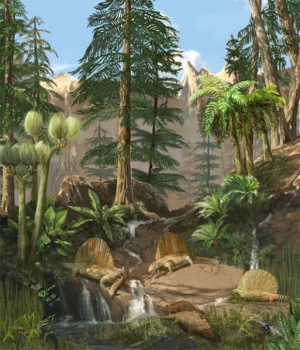
The most famous extinction occurred about 65 million years ago. It is famous for the fact that at this time dinosaurs became extinct on Earth. More than 15% of the families of marine animals and 18% of the families of land animals also died.
It is not entirely clear what led to this mass extinction. Scientists continue to study the Cretaceous and Paleogene periods of the Earth to find the cause of the disaster. The most famous theories say that the Earth collided with a large asteroid or was hit by radiation from a supernova explosion.
But in addition to “cosmic” reasons, there are suggestions that dinosaurs (as well as some other species of animals) simply could not adapt to the new vegetation, the rampant development that was observed at that time, and were simply “poisoned” by inedible leaves. Or they were exterminated by the first mammals, who destroyed the clutches of dinosaurs, preventing them from reproducing. The latter theory is supported by the fact that some dinosaurs lived for quite a long time on the territory of modern North America and India, where perhaps “dangerous” mammals appeared later.

Timeline of historical periods of the Earth. Triangles mark mass extinctions of animals.
Ecology
Life on Earth is always struggling to survive. Animals live under constant stress to get enough food and adapt to their environment.
Some animals that are poor at adapting to change experience difficulties, starve, stop reproducing, and eventually die out. Throughout the history of our planet, life has acquired new forms, which were immediately tested for survival.
Why did mass extinctions occur?
When the climate and environment changed greatly, many living things that could not adapt to the new conditions died. Mass extinctions of species have occurred more than once. With this phenomenon, life forms disappeared without a trace, leaving behind neither fossils nor descendants. Mass extinctions have occurred since the beginning of life on Earth.
All the animals that live on the planet today are just descendants of those creatures who were lucky and were able to adapt to a changed world. We invite you to look into the distant past and learn about the 10 most serious mass extinctions of flora and fauna on our planet.
1) Ediacaran mass extinction
During the Ediacaran period, complex creatures began to take on definite form for the first time. Tiny bacteria evolved into more complex life forms called eukaryotes, some of which began to form groups in order to increase their chances of finding food and avoiding the fate of becoming prey. Most of these creatures left nothing behind, since they did not have a skeleton. They were soft-bodied and completely decomposed after death, not being preserved in fossils.
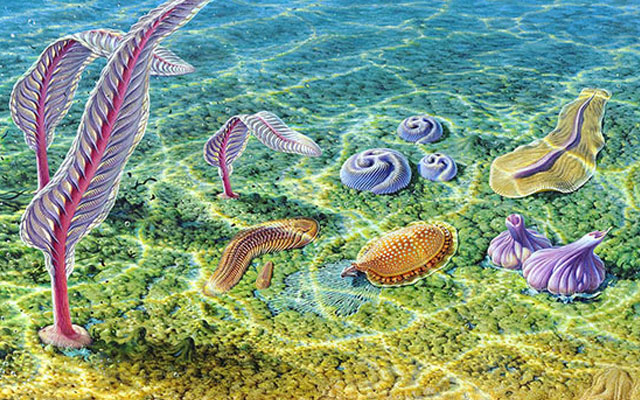
The first simple creatures
Only in very rare cases have creatures from Ediacaran times been able to reach us in fossils, for example, if the animal was left lying in soft mud, which hardened very quickly, so that an imprint was left on it. These few fossils tell us about the presence in the seas and oceans strange creatures, which resembled modern worms, sponges and jellyfish.
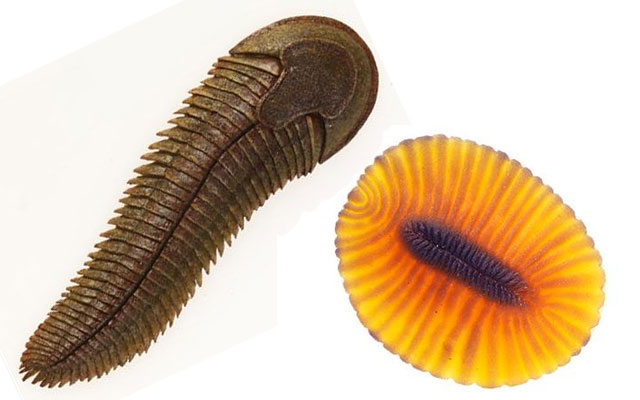
These animals depended on oxygen, just like you and me. Oxygen levels in the atmosphere began to fall 542 million years ago. That's when the mass extinction began. More than 50 percent of the planet's living beings died. A huge number of dead bodies of living beings have rotted into fossil fuels.
The reason why oxygen levels dropped is not yet known to scientists. However, this extinction also had positive consequences: it served as the impetus for the Cambrian Explosion, an unexpected diversity of complex creatures that were more complex than simple worms.
2) Cambrian-Ordovician extinction
During the Cambrian period, life flourished on Earth. Living things that appeared during the Ediacaran remained largely unchanged for millions of years, but after the onset of the Cambrian, life forms began to develop quite quickly, and a great variety of unprecedented living things evolved. Exotic crustaceans and trilobites became dominant. Shellfish and giant insect-like marine arthropods filled the seas. These creatures had hard outer shells, thanks to which they came to us in the form of fossils.
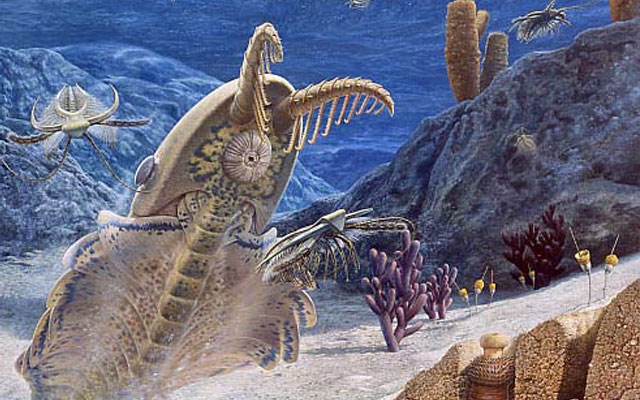
The Ice Age triggered extinction
Life on Earth was thriving until unexpectedly (from a geological perspective), 40 percent of all living things on the planet suddenly disappeared 488 million years ago. Those who managed to survive struggled to cope with the harsh environmental conditions. Scientists do not know what led to the mass extinction of this period.
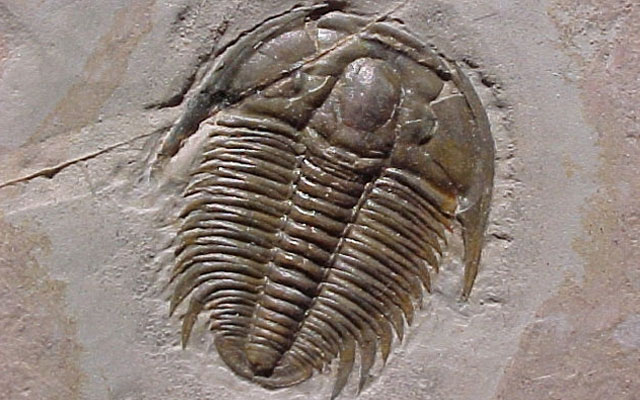
According to one theory, at this time there was an ice age, or rather, the coldest part of it. For the last 11 thousand years, the so-called "Interglacial". The extreme drop in temperature likely killed off a huge number of species. It was this mass extinction that marked the boundary between the end of the Cambrian and the beginning of the Ordovician.
3) Ordovician-Silurian extinction
Life on Earth began to flourish again during a period called the Ordovician. Nautiloids (primitive octopuses), trilobites, corals, starfish, eels and sponge fish filled the oceans. Plants gradually began to move onto land. Gradually life began to become more complicated.

Second worst mass extinction event
443 million years ago, more than 60 percent of life on Earth died in the second worst mass extinction in history. This extinction was associated with the abrupt onset of the Ice Age, which reduced carbon dioxide levels. Much of the waters, which were home to a huge number of living things, froze or became covered with ice caps and glaciers, causing oxygen levels to decrease.
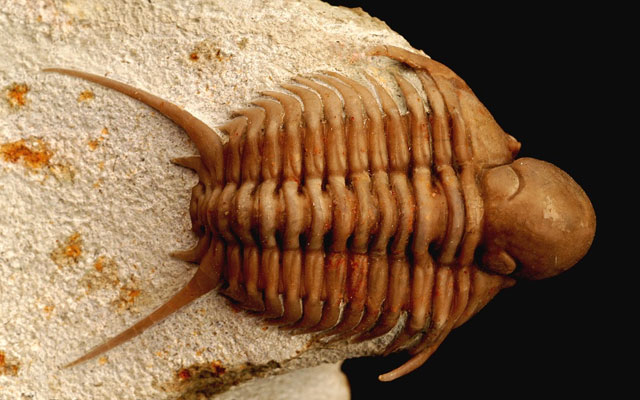
It is believed that a flash of gamma rays from space destroyed the ozone layer and ultraviolet radiation from the Sun began to break out onto the surface of the planet, which destroyed most plants. Fortunately, some managed to survive, but it took another 300 million years for the planet to fully recover.
4) Lau mass extinction
After the Ordovician-Silurian extinction, the Silurian period began. Life was again restored to the planet and at this time the first sharks and bony fish evolved, most of which are very similar to modern ones. Mosses and small plants began to grow freely on land along the coast, and some arthropods evolved into spiders and millipedes, which adapted to the dry air and began to live among plants along the coast.
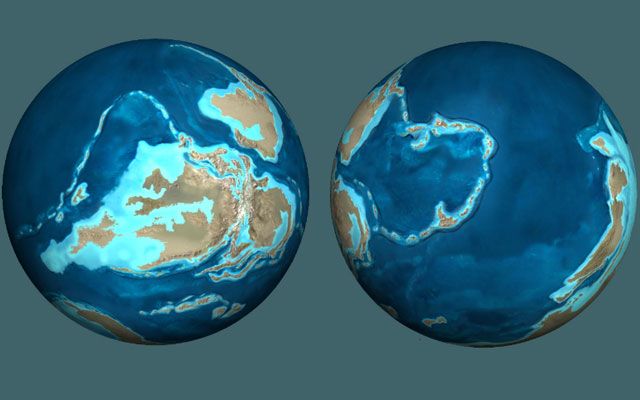
Variety of marine life
Giant sea scorpions were very diverse, and trilobites began to dominate. 420 million years ago there was a dramatic climate change that caused the extinction of about 30 percent of species. Atmospheric gases have changed in proportions, which has become uninhabitable and poisonous for many animals. The reasons for this event are unknown.
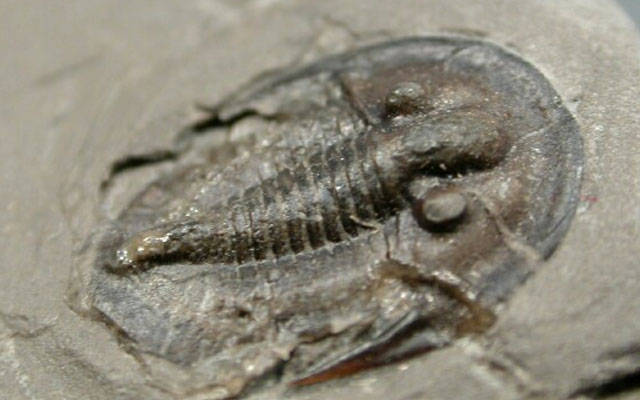
Life on the planet experienced serious difficulties until the end of the Silurian period and the beginning of the Devonian period, when evolution managed to produce completely different models of life that began to flourish and thrive.
5) Late Devonian mass extinction
During the Devonian period, some species of fish developed fins, which they began to use as limbs, allowing them to crawl on land. These living creatures eventually evolved into reptiles and amphibians. In the seas, giant coral reefs were filled with fish, including sharks, and other marine life, some of which fed on trilobites.

Successful sharks
Trilobites ceased to occupy a dominant position in the water for the first time in 100 million years, since they appeared. In fact, the sharks of this period were so successful that they no longer needed to change much. Some modern sharks look exactly the same as their distant Devonian ancestors.
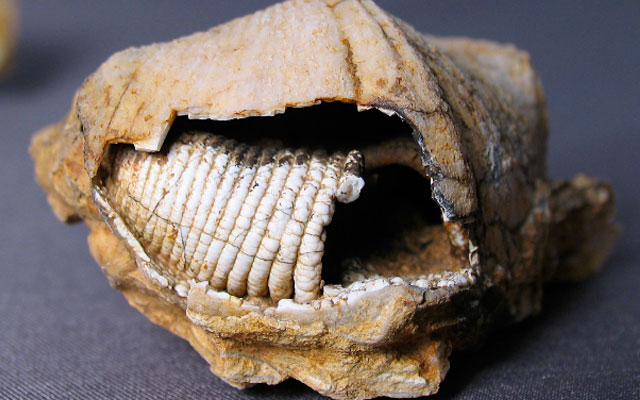
Land plants began to produce seeds and achieved great diversity. More complex plant species evolved on land, and soil appeared for the first time in Earth's history. Strange forests with 8-meter mushrooms have appeared, which today we can only see in science fiction films. However, 374 million years ago, 75 percent of all these amazing living creatures became extinct. This was again due to a change in atmospheric composition, probably due to intense volcanic activity or a meteorite impact.
6) Disappearance of tropical forests during the Carboniferous period
The Devonian period was followed by the Carboniferous (Carboniferous) period. Several land animals by this time had developed the ability to lay eggs on land, which allowed them to live anywhere rather than depend on water spaces coastal areas, where they used to lay their eggs, just like turtles do today. Flying insects appeared. Sharks enjoyed their golden age and the few trilobites that survived the last extinction became less and less common.
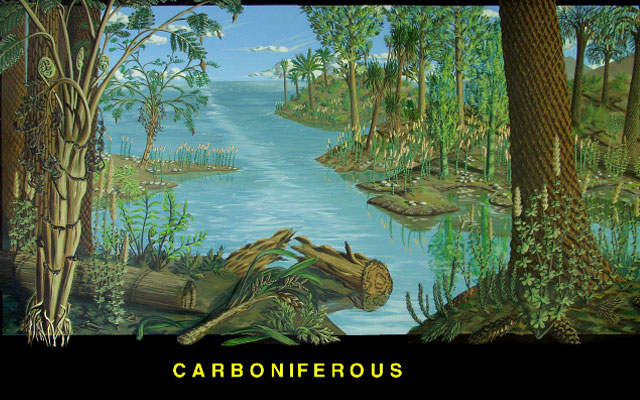
Carboniferous conifers have reached us
Giant trees appeared and huge tropical forests began to cover most of the land on our planet, increasing the oxygen content in the atmosphere to 35 percent. By comparison, our atmosphere today contains only 21 percent oxygen. Coniferous trees Carbona have remained virtually unchanged today.

305 million years ago there was a short but sudden ice age caused by a drop in carbon dioxide to record levels. Large forests began to die, and with them many land animals. At that time, about 10 percent of all living creatures on the planet disappeared. The trees began to rot and compact, which ultimately led to the formation of coal deposits, so this period was called the Carboniferous.
7) Permian mass extinction
After the giant tropical forests disappeared, the most successful animals that lay eggs remained on land. They quickly assumed dominant positions while other species were still recovering. A large number of a wide variety of reptiles and synapsids appeared, which resembled mammals and were their ancestors.

The worst disaster on Earth
252 million years ago, a catastrophe occurred that the Earth has never seen before or since. The changes followed a meteorite impact or volcanic activity that changed the composition of the atmosphere in a radical way. Between 90 and 99 percent of all living creatures on Earth died. This is the largest mass extinction in the history of the planet.
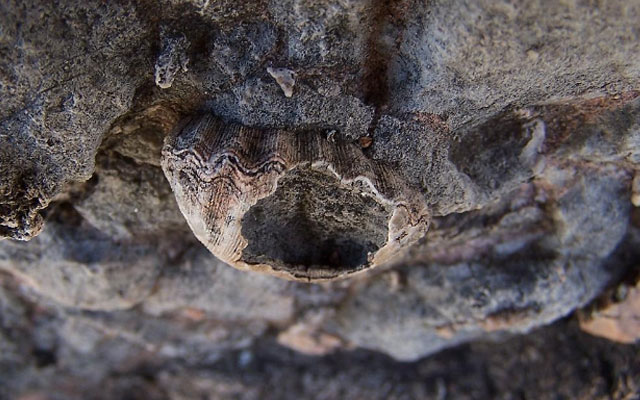
If we compare it with the extinction of species, which is caused by human activity, then in our history, we are responsible for the death of only 1 thousand species of animals. Since there are about 8 million known animal species on the planet today, that means only 0.01 percent have gone extinct. This is nothing compared to what happened during the Permian Mass Extinction.
8) Triassic–Jurassic extinction
After the devastation of the Permian period, reptiles again took dominant positions. Dinosaurs appeared. Dinosaurs did not occupy a leading position and at that time were no larger in size than horses. Their descendants became famous and scary creatures, which we all know about.

The beginning of the death of the dinosaurs
All large dinosaurs, tyrannosaurs, stegosaurs, triceratops and giant long-necked sauropod dinosaurs, appeared during the Jurassic and Cretaceous periods. 250 million years ago, 65 percent of Triassic living things went extinct, including all large land animals. Many dinosaurs survived due to their small size.
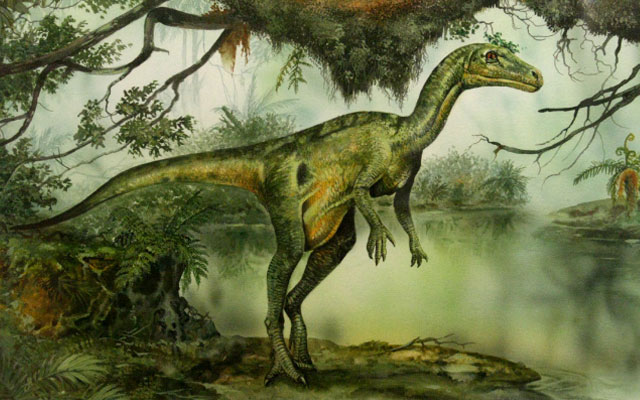
Most mass extinctions lasted about a million years, but this extinction occurred in just 10 thousand years. It was probably caused by intense volcanic eruptions that released into the atmosphere great amount carbon dioxide or sulfur dioxide, which has led to climate change.
9) Late Jurassic mass extinction
During the Jurassic period, giant marine reptiles such as the famous plesiosaur, dominated the oceans. Pterosaurs were the masters of the sky, and dinosaurs were the masters of the earth. Stegosaurs, long diplodocus, and carnivorous allosaur dinosaurs became widespread. Conifers, cycads, ginkgo trees and ferns made up most of the forest vegetation. Smaller dinosaurs acquired feathers, and the first birds began to appear.
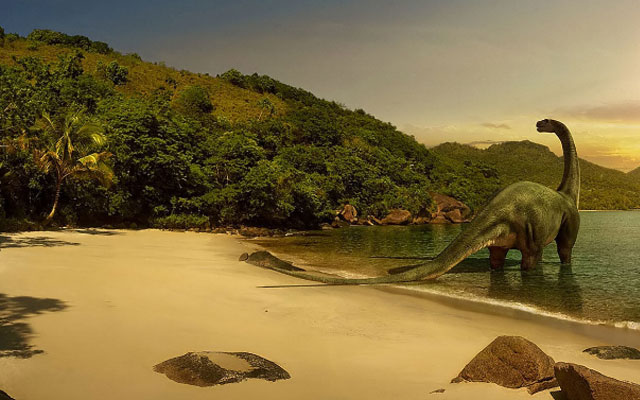
Death of seabed inhabitants
200 million years ago, about 20 percent of all these living creatures suddenly disappeared from the fossil record, mostly marine species. Shellfish and corals were widespread, but as a result of this event they almost disappeared. The few that survived gradually repopulated the seas over the next few million years. This mass extinction did not particularly affect land animals; only a few species of dinosaurs disappeared.
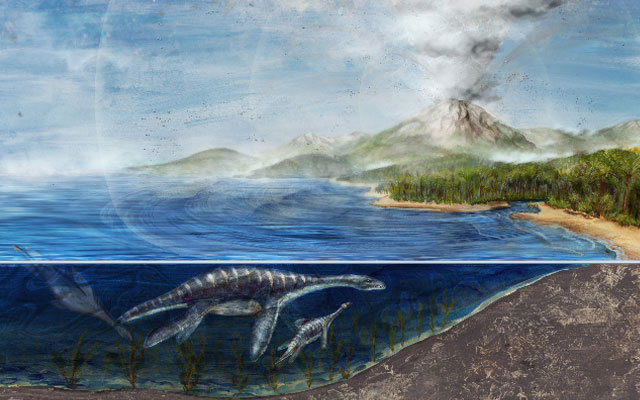
The cause of the extinction of marine animals is a matter of debate in the scientific world, but the leading theory is that the tectonic plates of the oceans may have sunk slightly, making the oceans deeper. Most of the marine life was adapted to shallow water, so it began to die, moving further and further from the surface.
10) Cretaceous-Paleogene extinction
This is the most famous mass extinction of species. After the Jurassic period ended, dinosaurs continued to reproduce and evolve into the subsequent period - the Cretaceous. These animals began to acquire an appearance that almost all modern children are familiar with. But most importantly, it was during the Cretaceous period that life finally finally recovered from its earlier Ordovician-Silurian extinction.

Death of the Dinosaurs
The number of species has only now reached Ordovician levels for the first time, a period that took place 300 million years before the Cretaceous. Synapsids eventually evolved into small, rodent-like creatures that were the first true mammals.
65 million years ago, a huge meteorite collided with the Earth in what is now Mexico, destroying the atmosphere and causing terrible global warming, causing the extinction of 75 percent of living things.

This meteorite contained a high concentration of iridium, a rare element on Earth. All Earth rocks that existed 65 million years ago contain a thin layer of iridium, which was left behind by a meteorite. Only some small reptiles and mammals managed to survive. Mammals replaced dinosaurs and became the dominant land animals on the planet.
FEDERAL STATE BUDGET EDUCATIONAL INSTITUTION OF HIGHER PROFESSIONAL EDUCATION
"Kaliningrad State Technical University"
(FSBEI HPE "KSTU")
Department of Ichthyology and Ecology
Causes of extinction of animal and plant species in the past and present
Coursework in the discipline
"Applied Ecology"
Kaliningrad
Introduction…………………………………………………….…………………………..…3
1 The concept of “endangered organism”, general characteristics of the causes of extinction of animals and plants…………………………………………………….……...………………………. …4
2Causes of extinction of species in nature……………………..….………………………….…9
2.1 Biotic factors……………………………………..………………………….….….10
2.2.Abiotic factors…………………………………………………………….………11
3Causes of extinction of species associated with human activity………………………………………………………..…………………………………………13
Conclusion………………………………………………………..………………………………………….…16
Sources used……………………………..…………………………………..…17
Introduction
The world's list of endangered species is growing at an alarming and unprecedented rate, while governments are paying less attention to conservation, environmentalists say.
According to the organization’s general director Achim Steiner, the rate of species extinction is accelerating and is already almost a thousand times higher than predicted. In the next 50 years, over 30 percent of existing animal and plant species will disappear from the face of the Earth.
The reasons for the extinction of organic forms and their groups are one of the problems that arouse burning interest among natural scientists of various specialties. In addition, it attracts the attention of everyone who is concerned about the development of nature. It is of paramount importance for the theory of evolution and occupies a prominent place in Darwinian teaching.
The number of species that make up the present organic world represents only a tiny fraction of the total number of species that have appeared on our planet from ancient times to our era.
1 The concept of “endangered organism”, a general description of the causes of extinction of animals and plants
Extinction is a gradually natural or sudden evolutionary process characterized by slow reproduction and increased mortality. Leads to a reduction in numbers and then to the complete disappearance of individuals of any systematic group of animals, including humans.
Extinction is the disappearance of any taxon from a species or higher as a result of the indirect influence of man and his economy, including the destruction of habitats. In an evolutionary sense, a group is considered extinct when it disappears without leaving behind any descendants. During the era of dinosaur extinction, one species disappeared every 1000 years, from 1600 to 1950 one species disappeared every 10 years, and currently one species disappears every year.
The term “endangered” or “endangered” has many nuances and its meaning can vary depending on the context. A species is considered completely extinct (extinct) when there is not a single living individual of that species left anywhere in the world. If only isolated individuals remain alive in captivity, or they are somehow preserved only under direct human control, then the species is said to have disappeared from natural ecosystems.
When the population size decreases to a certain critical level, the probability of its extinction becomes very high. In some populations, some remaining individuals may live for years or decades and even reproduce, but their future fate is still extinction, unless decisive measures are taken to preserve them. Such species are called potentially extinct: even if the species has not yet formally become extinct, the population is no longer able to reproduce, and the future of the species is limited by the lifespan of the remaining specimens. To successfully conserve species, biologists need to identify those human activities that affect the persistence of populations and lead to species extinction.
Groups of different sizes and different ranks are susceptible to extinction. It seems useful to us to distinguish five modal levels of extinction: 1) extinction of a species in most of its range; 2) extinction of the species as a whole; 3) extinction of phyletic groups of relatively low taxonomic rank, such as genera or families; 4) extinction of high-ranking groups, such as orders and classes: 5) mass extinction, covering many different groups in this era.
In general, groups of high taxonomic rank persist for longer periods of time than phyletic groups of low rank, and the latter in turn persist on average longer than species.
Ecologists have observed that not all species have the same probability of extinction; certain categories of species are especially susceptible to it and require careful protection and control:
Species with narrow ranges. Some species are found only in one or a few locations in geographically limited areas, and if the entire range is exposed to human activity, these species may become extinct. Numerous examples of this are the extinct species of birds that lived on oceanic islands. Many species of fish that lived in the region also disappeared. the only lake or in the basin of one river.
Species formed by one or more populations. Any population of species can become locally extinct as a result of earthquakes, fires, disease outbreaks and human activity. Therefore, species with many populations are less susceptible to global extinction than species that are represented by only one or a few populations.
Species with small population sizes, or the “small population paradigm.” Small populations are more likely to go extinct than large ones because they are more susceptible to demographic and environmental changes and loss of genetic diversity. Species characterized by small population sizes, e.g. large predators and highly specialized species are more likely to go extinct than those characterized by large populations.
Species in which the size of populations gradually decreases, the so-called “population decline paradigm.” In normal cases, populations tend to regenerate themselves, so a population showing persistent signs of decline is likely to disappear unless the cause of the decline is identified and eliminated.
Species with low population densities. Species with an overall low population density, if the integrity of their range has been disrupted by human activity, will be represented in low numbers in each fragment. The population size within each fragment may be too small for the species to survive. It is beginning to disappear throughout its entire range.
Species that require large habitats. Species in which individuals or social groups They forage over large areas and are prone to extinction if part of their range is destroyed or fragmented by human activity.
Types of large sizes. Compared to small animals, large animals usually have larger individual territories. They need more food and are more often hunted by humans. Large predators are often exterminated because they compete with humans for game, sometimes attack domestic animals and people, and they are also the object of sport hunting. In each guild of species, the largest species are the largest predators, the largest lemur, the largest big whale- are most susceptible to extinction.
Species incapable of dispersal. During natural course natural processes environmental changes force species to adapt either behaviorally or physiologically to new conditions. Species unable to adapt to a changing environment must either migrate to more suitable habitats or face extinction. The rapid pace of human-induced change often outpaces adaptation, leaving migration as the only alternative. Species that are unable to cross roads, fields and other human-disturbed habitats are doomed to extinction as their “native” habitats are transformed by pollution, the invasion of new species or due to global climate change. Low dispersal ability explains why 68% of shellfish species among aquatic invertebrates in North America have disappeared or are at risk of extinction, in contrast to dragonfly species, which can lay eggs while flying from one body of water to another, so for them the figure is 20%.
Seasonal migrants. Seasonally migratory species are associated with two or more widely separated habitats. If one of the habitats is disturbed, the species cannot exist. The survival and reproduction of the billions of songbirds of the 120 species that migrate between Canada and South America each year depend on the availability of suitable habitat in both territories. Roads, fences or dams create barriers between essential habitats that some species need to complete their entire life cycle. For example, dams prevent salmon from moving up rivers to spawn.
Species with low genetic diversity. Intrapopulation genetic diversity sometimes allows species to successfully adapt to a changing environment. When a new disease, new predator, or other change emerges, species with low genetic diversity may be more likely to go extinct.
Species with highly specialized requirements for an ecological niche. Some species are adapted only to unusual types of rare, scattered habitats, such as limestone outcrops or caves. If the habitat is disturbed by humans, this species is unlikely to survive. Species with highly specialized dietary requirements are also at particular risk. A striking example of this is the species of mites that feed only on the feathers of a certain type of bird. If a bird species disappears, so does the feather mite species.
Species living in stable environments. Many species are adapted to environments whose parameters vary very little. For example, living under the canopy of the primary rainfall tropical forest. Often such species grow slowly, have low reproductive rates, and produce offspring only a few times in their lives. When rainforests are cut down, burned, or otherwise altered by humans, many species living there are unable to survive the resulting changes in microclimate (increased light, decreased humidity, temperature fluctuations) and competition with early successional and invasive species.
Species that form permanent or temporary aggregations. Species that form clusters in certain places are very susceptible to local extinction. For example, the bats At night they feed over a large area, but usually spend the day in a specific cave. Hunters who come to this cave during the day can collect the entire population to the last individual. Herds of bison, flocks of passenger pigeons and schools of fish are aggregations that were actively used by humans, until the complete depletion of the species or even extinction, as happened with the passenger pigeon. Some species of social animals cannot survive when their population numbers drop below a certain level because they can no longer forage, mate, or defend themselves.
Species hunted or collected by humans. The prerequisite for the extinction of species has always been their utilitarianism. Overexploitation can rapidly reduce the population size of species of economic value to humans. If hunting or gathering is not regulated by law or local customs, species may become extinct.
These characteristics of endangered species are not independent, but are grouped into larger categories. For example, species of large animals tend to form populations with low densities and large ranges—all characteristics of endangered species. Identifying such characteristics helps biologists take early action to conserve species especially in need of protection and management.
In cases where extinctions occurred in the geological past, the reasons for them are difficult to determine. The reasons for the extinction of species that are particularly well represented in the fossil record in the Quaternary are unclear, and it is not surprising that the problem becomes more complex as we move deeper into geological time and move from the species level to large groups and mass extinctions.
So, consideration of the reasons for the disappearance of groups of organic forms has often led serious researchers to the conclusion that it is not possible even in general terms to imagine the factors that could destroy these groups, that such events cannot be explained on the basis of the action of the forces of nature familiar to us.
And yet, numerous types of explanations for the causes of extinction are quite widespread among biologists, for example:
Hypotheses of “internal” causes of extinction;
Theories of “monodynamic” or “shock” factors of extinction;
Hypotheses for the causes of extinction in the works of Darwin, Neumayr, Andrusov;
Separate hypotheses for the causes of extinction regarding each species;
Extinction dependent on local and regional changes in abiotic environmental conditions.
In the history of earthly life, scientists count up to 11 mass extinctions of flora and fauna, 5 of which greatly changed the appearance of our biosphere. The last of these “Great” extinctions, which occurred 65 million years ago, destroyed 1/6 of all species that existed then (Cretaceous-Paleogene extinction).
At the same time, along with sea and flying lizards, the most “promoted” order of animals in the fossil record of our world disappeared - all dinosaurs.
Modern science does not have comprehensive data on the causes of the last major extinction of species (as well as the previous ones). The main suspects include asteroids, volcanoes and internal processes in the earth's biosphere. Below, I invite you to familiarize yourself with the chronicle of earthly catastrophes, 300 million years long, and form your own opinion about the reasons for the death of this wonderful order of reptiles.
"Mother of all extinctions"
250 million years ago, the largest known extinction event in the history of our planet occurred; the Permian-Triassic catastrophe killed 95% of all species of marine and land animals. Almost all the therapsids that dominated the land at that time disappeared. Among the few surviving therapsids were the ancestors of the cynodonts, from which all mammals are descendants.
Animal-like lizards (synapsids) include Early Permian pelycosaurs (Dimetrodon on the left) and their therapsid descendants (Gorgonops on the right). In particular, gorgonopsians are the closest relatives of cynodonts

The vacated ecological niches of therapsids were occupied by archosaurs, which within 20 million years would begin to dominate as land predators (dinosaurs and crurotarsians).
The main cause of this extinction is usually considered to be the outpouring of magmatic Siberian traps at the boundary of the Permian and Triassic periods. During the formation of the traps, about 4 million km3 of rocks were thrown out, covering an area of 2 million km2. The process of outpouring of rocks triggered a cascade reaction of global climate change, which ultimately presumably caused the mass extinction.
The area of the eruption of the Siberian traps superimposed on the map of modern Russia
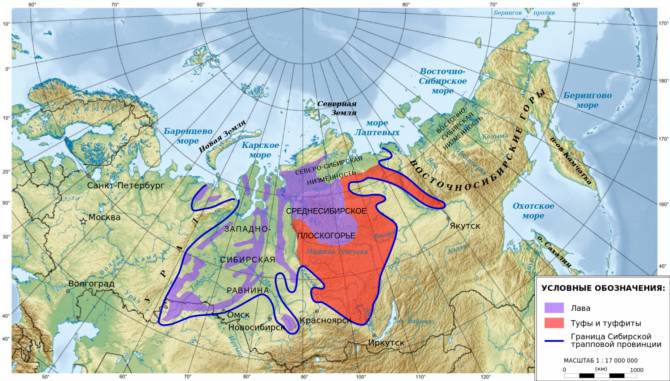
“Mysterious” Triassic-Jurassic extinction
After 50 million years, the earth's biosphere had to face another series of mass extinctions. At the border of the Triassic and Jurassic periods, an unknown global cataclysm found the Crurotarsians dominating the land. Having supplanted their “cousins” dinosaurs and mammals, crurotarsians had by that time become the main and largest land predators of the Late Triassic.
Some representatives of the predatory crurotarsians of the Late Triassic

As a result of the disaster, crurotarsians shared the fate of the therapsids, giving way to their “cousins” - the dinosaurs, which would dominate the land for a long 140 million years. One of the two surviving groups of crurotarsians, the protosuchians are the direct ancestors of modern crocodiles.
The main versions of this extinction are considered to be the fall of a large asteroid and volcanic activity (Central Atlantic Igneous Province, CAMP). In the first case, the impact of a 4 km asteroid that formed the 100 km Manicouagan crater in Canada was considered as the cause, but geological dating places its fall 14 million years before the Triassic extinction.
Today, the Manicouagan crater has a transverse diameter of 70 km (originally 100 km). Craters of this size usually occur when asteroids with a diameter of about 4-5 km fall, and do not have long-term consequences for terrestrial fauna and flora
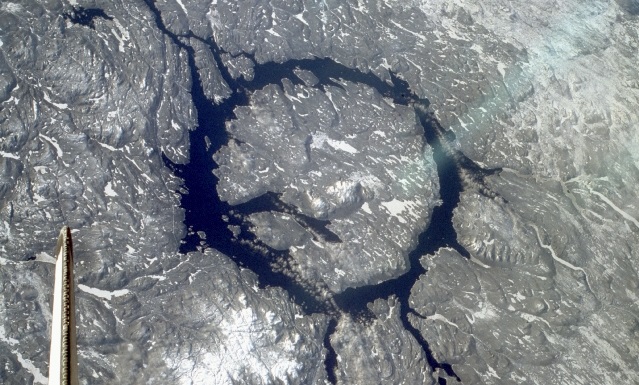
The combined hypothesis received the greatest support. According to it, the CAMP, which caused the outpouring of 2 million km3 of volcanic rock, including a huge amount of CO2, provoked the release of huge bottom ocean “pockets” of methane hydrates through global warming. Methane, being a stronger greenhouse gas than CO2, triggered a chain reaction of overheating of the earth's atmosphere, which presumably caused mass extinctions.
"Stable" Mesozoic
The period of dinosaur dominance on land (the Jurassic and Cretaceous periods of the Mesozoic era) was not at all geologically “quieter” than other periods of earth’s history.
183 million years ago there was a large magmatic outpouring of the Karoo-Ferar, comparable in scale to the CAMP (2.5 million km3 of igneous rocks). However, this event did not cause any catastrophic consequences for earthly life. The collision with the Earth of a large asteroid with a diameter of approximately 4 km 167 million years ago - in the middle of the Jurassic period (the destroyed Puchezh-Katunsky crater in the Nizhny Novgorod region of Russia) also passed without serious consequences.
The second mass extinction in the history of dinosaurs occurred at the boundary of the Jurassic and Cretaceous periods - 145 million years ago. One of many hypotheses associates this “Little Jurassic” extinction with the formation of one of the largest shield volcanoes solar system- Tamu massif Pacific Ocean. However, it is possible that the global effect of the formation of the volcano increased the impact of a 4 km asteroid in the same period of time (Morokweng crater, South Africa). To this time, scientists attribute the appearance of flying dinosaurs - the ancestors of modern birds.
The Tamu Massif in the Pacific Ocean is one of the largest extinct volcanoes solar system. The total mass of the rocks composing this ancient volcano is 80% of the mass of the Martian Mount Olympus
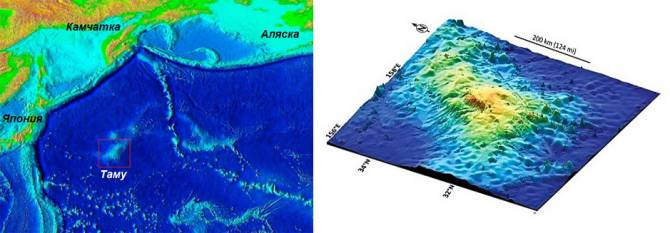
Approximately 12 million years later, already at the beginning of the Cretaceous period, the world's flora and fauna experienced a series of major explosive events. volcanic eruptions in earthly history. The eruption of 8 supervolcanoes at the beginning of the Hauterivian stage of the Cretaceous period released a total of 50,000 km3 of gases and rocks. Thus, the eruption of each supervolcano was on average twice as powerful as the eruption of the Toba supervolcano, which 70,000 years ago caused the “bottleneck” effect.
The fact is also noteworthy because the “parade” of supervolcanoes was only part of the process of formation of the giant Parana-Etendeka magma traps in South America. The total volume of released rocks was 2.3 million km3. However, just like 50 million years earlier, these processes did not cause significant fluctuations in the diversity of the earth’s biosphere.
Scarps formed by basalt flows of ancient magma traps of Parana, Brazil

By the end of their era, dinosaurs experienced 3 more major peaks of volcanic activity, which in total erupted 12 million km3 of rock. During the Cretaceous, the Earth also experienced a series of collisions with large asteroids (3 asteroids with a diameter of 1 km, three more with a diameter of 2 km, and one with a size of 3 km).
The largest (after Chicxulub) impact crater of the Cretaceous period - Kara is located in the Nenets Autonomous Okrug Russia. The impact of a 3 km asteroid 70 million years ago formed a crater with a diameter of about 70 km. The beginning of the decline in dinosaur speciation is also attributed to the same period, although the connection between these two events is a matter of debate
The end of eternity
If we could get to the end of the Cretaceous period, many of us would not believe that we were in an ancient and alien world. Angiosperms (flowering plants) dominated everywhere, and mammals, little different from modern small animals, romped about underfoot.
They have already managed to divide into placentals and marsupials. The first primates lived at the same time. Snakes and the familiar lizards appeared. Since the Jurassic period, forests have been teeming with real birds, and their relatives, crocodiles, ambushed animals that came to the river.
Bees are also thought to be partly responsible for the decline in dinosaur diversity in the Late Cretaceous. Having evolved about 100 million years ago from wasps that fed on pollinating insects, bees, thanks to their high efficiency, made flowering plants dominate the earth's flora. Herbivorous dinosaurs had some difficulty slowly changing their diet from gymnosperms to flowering plants
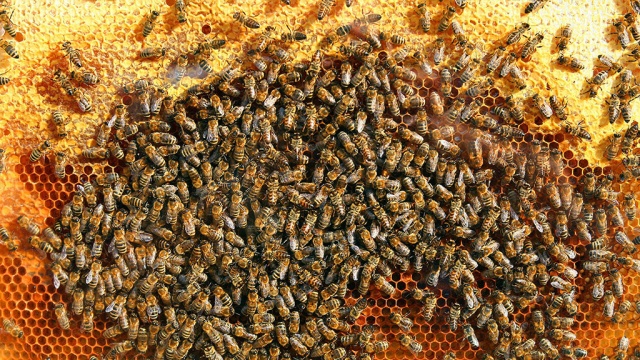
Similar features of our world with that ancient one are limited to the composition of the fauna at the mental watering hole, most of which were still dinosaurs: tyrannosaurids, ceratopsians, hadrosaurs, sauropods, etc. (more detailed list fauna of the end of the era of dinosaurs).
Towards the end of the era of dinosaur dominance, at the border of the Cretaceous and Paleogene periods, volcanic activity increased in India (then an island in the middle Indian Ocean). The volume of outpouring of the Deccan Traps over several hundred thousand years amounted to about 2 million km3, the peak occurred with the lava eruption of the Mahabaleshwar-Rajamundry trap, when during a short (geologically) period the volume of emissions amounted to 9 thousand km3 of rocks.
Deccan Traps near Mumbai and map of the area they occupy in India (in blue)
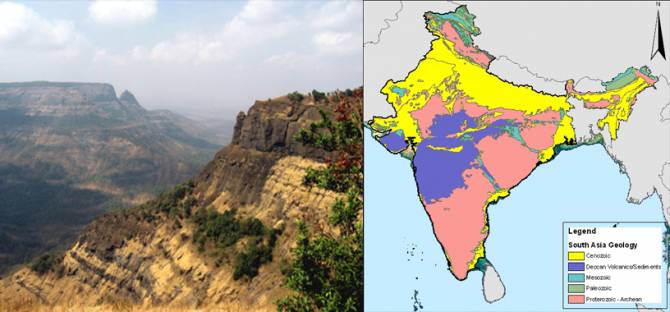
However, from previous precedents of colossal volcanic activity, we already know that such phenomena in themselves do not necessarily have a catastrophic effect on the earth’s climate, and, accordingly, flora and fauna. Most likely, such activity must coincide with exceptional circumstances to trigger the “mechanism” of mass extinction.
Only 6 of the 11 major extinctions coincided with active geological processes. Most modern paleontologists are of the opinion that such an “exceptional circumstance” was the impact of a 10 km asteroid in Central America 65 million years ago, during the active phase of the formation of the Deccan Traps.
The power of the impact was unprecedented in the history of the Mesozoic era. The energy released was 2 million times higher than the energy of the explosion of the largest thermonuclear charge - the “Tsar Bomb”. The area of the 180 km Chicxulub crater formed was comparable to the total area of all impact craters formed in the previous 200 million years.
According to some geological models, the seismic wave from the explosion could be focused at the antipode of the impact crater and cause lava eruptions (or intensify them). By the way, at the antipode point of the collision there was then a region of increased volcanic activity - those same Deccan Traps.
The hypothesis does not at all claim that volcanism was provoked by an asteroid impact, since the formation of these traps was a purely autonomous process of the earth’s lithosphere. We are talking exclusively about a possible short-term increase in volcanic activity, since the phenomenon of “seismic focusing” in the particular case of the Earth is very limited.
Chicxulub crater on the Yucatan Peninsula (Mexico). On the left is a crater in the visible range, on the right is an overlay of a map of gravitational anomalies
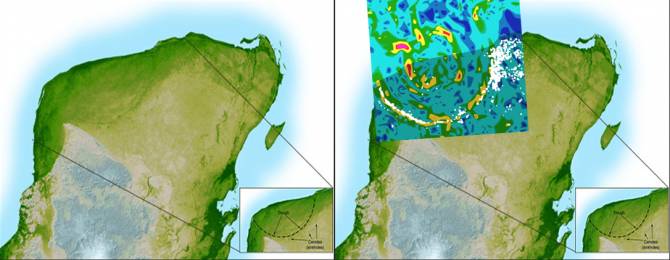
Another important condition for the start of the process of mass extinction is the state of flora and fauna at the time of “force majeure”. As before the Permian-Triassic extinction event, paleontologists record a decline in the diversity of dinosaurs and other archosaurs in the Maastrichtian stage of the Late Cretaceous (the last 7 million years of dinosaur existence).
This is associated with global climate change, since the reduction in diversity extended to many other groups of animals and plants (including mammals, birds and flowering plants). This gave rise to many paleontologists to assume that these two catastrophic events (volcanoes and an asteroid) occurred at an “inconvenient” time for living fauna.
A graph of the frequency of magmatic eruptions (scale on the right) and asteroid impacts (scale on the left) over the last 300 million years (of those confirmed). The former have a relatively long-term effect on the climate (millions of years); the impact of asteroids is “survived” by nature for several tens of thousands of years. As you can see, natural disasters do not always provoke mass extinctions (red dots at the top are large extinctions, black dots are small)
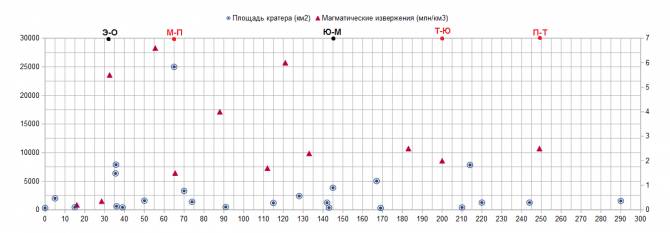
Graph of “short-term” volcanic eruptions over the past 140 million years. Unlike explosive eruptions, lava eruptions are not accompanied by significant explosive releases of molten rocks. The eruption process occurs relatively calmly. The red circle indicates the eruption of the Toba supervolcano, 70 thousand years ago.

"The Great Break"
The last of the major extinctions and the fourth for mammals occurred at the border of the Eocene and Oligocene epochs of the Paleogene period 35-30 million years ago. The percentage of species extinction was several times higher than the “background” level - more than 3% versus 0.7% (an order of magnitude weaker than the Cretaceous extinction).
This, the longest of all extinctions of the last 300 million years, lasted 4 million years. The Eocene-Oligocene extinction is associated with both the fall of two large asteroids 35 million years ago (~5 and ~4 km in diameter, respectively), and with significant global volcanic activity 35-29 million years ago (Northern, Central and South America, Africa and the Middle East, see graph above).
100 and 90 km craters Popigai (Russia) and Chesapeake (USA), formed with a short time interval of 35 million years ago, and presumably became one of the reasons for the Eocene-Oligocene extinction and general climate cooling in the Oligocene
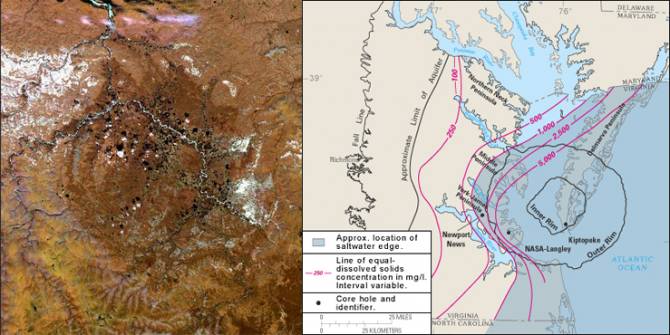
"Leviathans"
However, according to many modern biologists, the Eocene-Oligocene extinction was not the last. Since the last ice age, 11,000 years ago, the Earth's biosphere began to experience the next "Great Dying" in its history (the Holocene extinction).
It has already exceeded the scale of the Eocene extinction, and according to scientists, the species diversity of the fauna of our planet will decrease by 50% at the end of this century (more than 80% for the earth's flora). And the reason for this is not volcanoes or asteroids at all, but the appearance and development of a very unusual species of animals - Homo sapiens.
As can be seen in the illustration below, the appearance of humans most often provokes a sharp decline in the number of large mammals (Megafauna). In Africa and South Asia the effect was weaker as the fauna gradually adapted to coexist with successive human species. On other continents, where the emergence of the “super hunter” was relatively abrupt, the reduction effect was much more significant

Unfortunately, we often forget that human intellectual superiority over the rest of living nature must be accompanied by great responsibility, and not by predatory and often irrational plunder and destruction of its benefits.
Let’s hope that things won’t come to the “Great Anthropogenic Extinction”, and if it does, we won’t perish in the same abyss into which we will sweep away most of the earth’s biosphere...
You know that the development of living nature, as a rule, follows the path of increasing complexity of organization. Why do some species become extinct and are replaced by others?
The main directions of the evolutionary process are biological progress and regression. These directions were identified by A.N. Severtsov and I.I. Shmalgauzen.
Biological progress is characterized by an increase in the number of individuals of a systematic group, an increase in the number of species, subspecies, and populations included in it, and an expansion of the range. Species in a state of biological progress emerge victorious in the struggle for existence.
Biological progress can be achieved through aromorphoses, idioadaptations or degeneration. For example, the biological progress of angiosperms was facilitated by aromorphoses - the appearance of a flower and a fruit, which led to a significant improvement in the processes of pollination, fertilization, formation and distribution of seeds, and plant reproduction in general.
The further evolution of angiosperms followed the path of idioadaptations, the emergence of various adaptations to different living conditions. Idioadaptations led to the appearance of plants with different flowers, fruits, shoots, leaves, root systems, development periods, adaptations to pollination by wind, water, and insects. Thanks to idioadaptations, a large number of species of angiosperms have emerged.
Biological regression is a direction of evolution that is characterized by a decrease in the number of species, subspecies, populations, and a reduction in range. Biological regression has affected many species of amphibians and ferns. The end result of regression is the extinction of the species.
The cause of biological regression is often human activity. Humans influence species directly by destroying them, or indirectly by changing their habitat. So, at the beginning of the 17th century. - wild bulls - aurochs - were exterminated. By the second half of the 18th century. were completely destroyed marine mammals- Steller's cows. By the beginning of the 19th century. hunters completely exterminated the large flightless moa birds that lived in the forests of New Zealand, reaching three meters in height.
There are other reasons for the extinction of species. The evolution of species is determined by the interaction of natural selection and the characteristics of the biological organization of species. However, the possibilities for evolutionary changes in a species are not unlimited; there are evolutionary restrictions. For example, each species is characterized by a certain spectrum of mutations. Some mutations are impossible due to the lack of genetic prerequisites. Thus, in fly drosophila mutations are impossible that would determine the appearance of individuals with green or blue eyes.
Sometimes the most successful adaptation that promotes progress becomes the cause of evolutionary limitations at a certain stage of development. For example, the appearance of tracheas (air breathing organs) in insects gave them ample opportunities for mastering the air habitat. However, with the appearance of tracheas in insects, the circulatory system became more simply structured, as a result, the supply of nutrients to the organs deteriorated, which led to a decrease in body size. The largest extinct dragonflies reached a length of 75 cm, and the largest modern insects do not exceed 12-15 cm.
Thus, limiting factors limit the possibilities for further evolutionary changes and often lead to biological regression.
